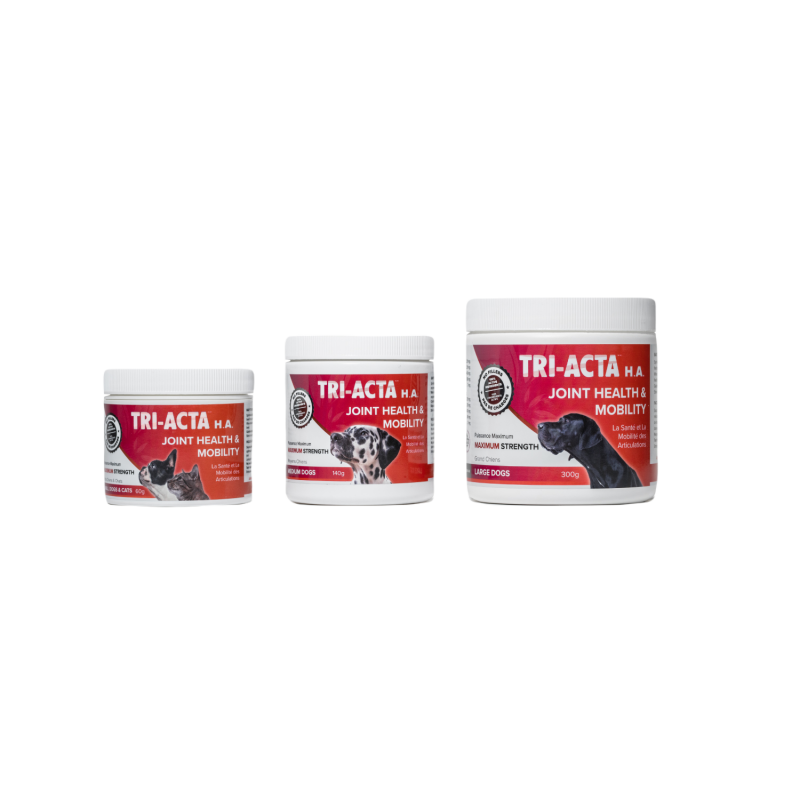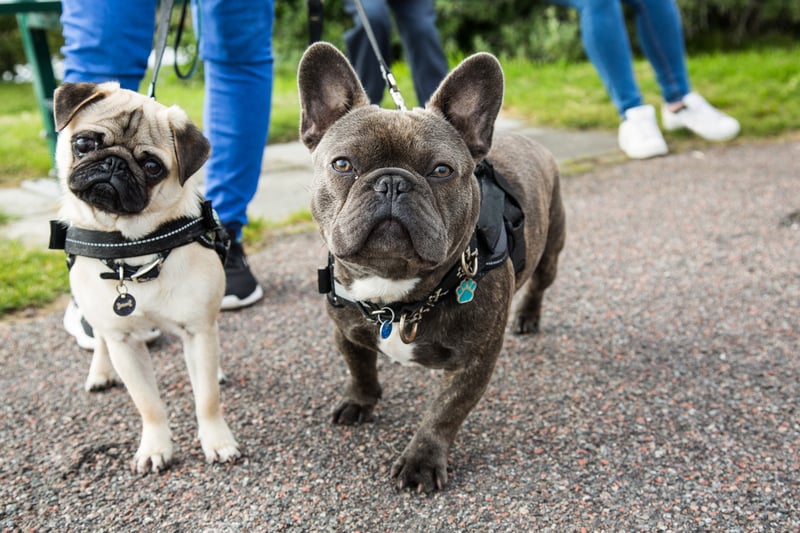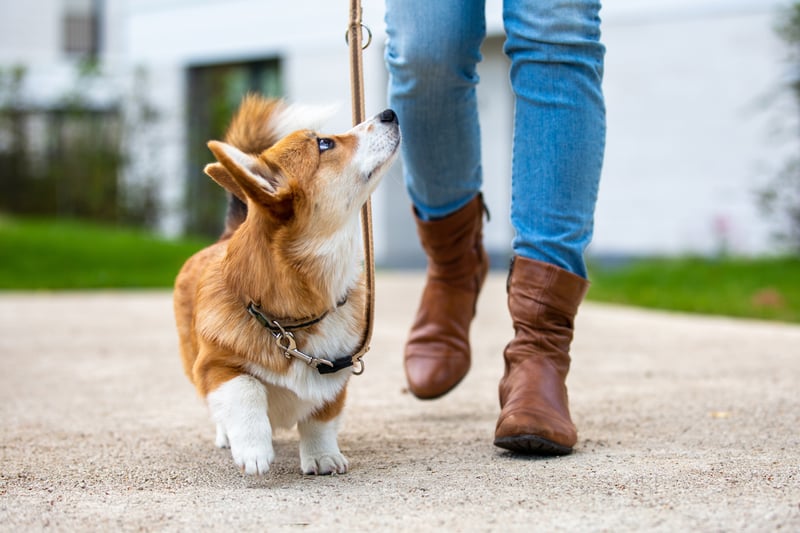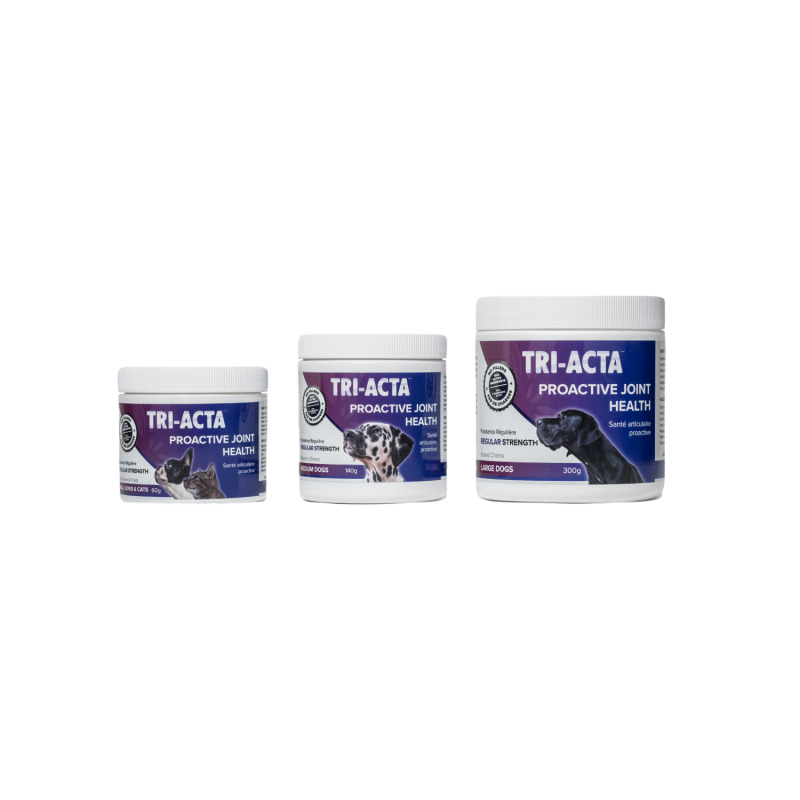Table of Contents
It can be scary when we notice our pup has a sudden change in their gait.
While a hefty vet bill may weigh at the back of our minds, our top priority is ensuring our pooch is not in pain.
But is it safe to assume that all is well when our dog is limping, but no pain is obvious?
Spoiler alert! A dog limping is a sign of pain. So we need to reframe the question of “why is my dog limping but has no pain” to why they might show minimal signs of discomfort.
Keep in mind, our four-legged friends tend to be much less whiny than our two-legged little ones. Dogs are quite talented at hiding pain and discomfort, especially when they hear the rustle of a bag of kibble or the magic word “walk”.
In this post, you’ll learn about the possible causes of a dog limping but no pain, as well as how to treat them. We will also de-bunk some common myths around the topic of ‘dog limping no pain’. Finally, we will give you our favourite tips on how to prevent limping from puppyhood to senior dog years.
Is It Bad if My Dog Is Limping but No Pain?
Well, as we said before, limping is a sign of pain. Limping not accompanied by physical symptoms like bleeding, swelling, or dangling limbs or behavioural changes like aggression or irritability is likely a milder form of pain.
Vets typically rate the severity of limping in three stages:
- Mild: The dog appears happy and content while bearing less weight on the affected foot or leg.
- Moderate: The dog appears lethargic and has noticeable changes in walking while bearing less weight on the affected foot or leg.
- Severe: The dog displays changes in behaviour, such as aggression and cannot bear any weight on the affected foot or leg.
Limping is also categorized as acute or chronic:
- Acute: Limping for less than two weeks. Requires a pain severity assessment to determine whether or not it is an emergency.
- Chronic: Ongoing limping for two weeks or more. Usually not a sign of an emergency, but it gets progressively worse with time.
Acute limping from minor injuries or irritation from a foreign object can often be treated at home and resolved independently. Severe trauma and injuries (e.g., car accident, strain or sprain caused by twisting movements catching a frisbee or ball) that cause acute limping are likely to develop into chronic, so taking your dog to a vet is a good idea in these cases. Chronic or ongoing limping that stops and resumes usually indicates a degenerative joint disease, another joint-related condition, or unresolved trauma.
It is always best to call your vet for a physical exam if you suspect a serious injury or ongoing condition. Giving your pup a joint supplement like TRI-ACTA H.A. for Pets is a great way to help them heal. It has no fillers or additives and is packed with active ingredients such as glucosamine for dogs, chondroitin, MSM (a naturally occurring anti-inflammatory), and hyaluronic acid, which helps alleviate symptoms of limping over time.
TRI-ACTA H.A. for Pets
Our maximum strength formula is optimally designed to accelerate the formation of cartilage, minimize inflammation, expedite the healing process, and improve joint conditions.

What Does It Mean if Dog Was Limping but Stopped?
If a dog is limping and suddenly stops, or if it is limping on and off, it most likely means the problem is to do with his or her soft tissue.
Soft tissue body parts include:
- Muscles
- Tendons
- Ligaments
Along with the bone, cartilage, and synovium, these soft tissue body parts make up a joint. When your pup damages the soft tissue where their bones connect, it can lead to various dog joint health concerns.
There are several possible reasons why your dog was limping but stopped:
1. Masking the Pain
Animals masking or hiding pain from their owner is animal instinct. In the wild, animals that appear weak or in pain are more vulnerable to predators. If the animal has mild to moderate pain, it will be better at hiding it for longer periods.
2. Soreness
Some conditions or issues get worse after strenuous exercise or physical activity. Your dog may limp more after a walk or some leisure time in the yard because it makes their injury sore and unable to bare weight.
3. Adjusting Their Weight
It might be hard to tell, but your dog may still be limping. They might have changed the weight to another foot and are limping differently or bending their leg inward to adjust the weight.
4. Chronic Conditions
If your dog’s limping stops and starts but persists for longer than a couple of weeks, they are more likely to suffer from degenerative joint disease or another condition like luxating patella or hip dysplasia.
Myths About Dog Limping but No Signs of Pain

Dogs limping and or lameness in dogs is a very common occurrence. Since limping can be caused by several reasons, there are many myths around the topic of “dog limping but no signs of pain.”
These are the most common myths:
- My dog is acting normal, so they’re not in pain.
- My dog’s limp will go away on its own.
- My dog is lifting his leg up. He must have hurt his foot.
- My dog has been limping on and off for a year. It’s no big deal.
- My vet gave my dog pain medication, and now he’s fine.
Let’s debunk some of these myths, shall we?
My Dog Is Acting Normal, so They’re Not in Pain.
We’ve said it before and will say it again, but a dog limping is a sign of pain. Limping shows that your pooch is having difficulty placing weight on a particular limb because it causes them pain.
My Dog’s Limp Will Go Away on Its Own.
In some cases, this is true, and a dog limping but showing no signs of pain means the injury may resolve on its own. However, you still need to make modifications to allow your dog to heal, such as confining them to a crate or room, eliminating hazardous objects to trip on, and monitoring yard time. Giving your dog TRI-ACTA H.A. is another great way to help them heal from a joint injury. The addition of hyaluronic acid in our H.A. formulation improves the viscosity of the synovial fluid in your pup’s joints, giving him great joint protection and helping with the healing process.
My Dog Is Lifting His Leg Up. He Must Have Hurt His Foot.
While it’s possible that a dog limping with no pain could be a minor paw injury, such as a foreign object stuck or a broken toenail, your dog may have hurt any tendon, ligament, bone, or muscle in their leg or hip. To determine whether these things have occurred, bringing your pup to the vet for a physical examination is a good idea.
My Dog Has Been Limping on and off for a Year. It’s No Big Deal.
Suppose a dog is limping but no pain, and you allow it to go on unchecked for a significant amount of time. In that case, the injury can grow and develop into conditions such as arthritis, weak muscles, and secondary ailments resulting from a poor range of motion.
My Vet Gave My Dog Pain Medication, and Now He’s Fine.
Suppose your vet has prescribed NSAIDs (Nonsteroidal Anti-Inflammatories) to treat pain and inflammation. In that case, you must be especially cautious about monitoring your pups as they recover from injury or manage symptoms of illness. Just because the pain has improved, it doesn’t mean the problem is resolved, so using the injured leg could lead to more complications. NSAIDs are great, but they can cause secondary issues like liver and kidney damage if they’re used for too long. TRI-ACTA H.A. is a great alternative to NSAIDs and can even be used in conjunction with them to promote healing and help your dog get off the anti-inflammatories faster.
TRI-ACTA H.A. for Pets
Our maximum strength formula is optimally designed to accelerate the formation of cartilage, minimize inflammation, expedite the healing process, and improve joint conditions.

Causes of Dog Limping but No Pain
Sometimes, it can be hard to determine if your dog is limping but no pain. When a pooch doesn’t show signs of pain and discomfort, it makes diagnosing all the more challenging.
The causes of limping or lame dogs can be categorized into three sections:
- Paw injury
- Diseases and disorders
- Injury and trauma
The chart below show a breakdown of the most common issues in each category of limping causes.
|
Paw Injury |
Diseases & Disorders |
Injury & Trauma |
|
|
|
Some causes like burns and frostbite will be visible, and serious problems like a broken bone cause your pup to be in severe pain.
How to Tell if Your Dog Limping but No Pain
Performing a simple lameness exam at home will help you narrow down the affected limb and body part causing the limp. This way, you can rule out something simple like a paw injury caused by a foreign object or broken toenail or if you’ll need to call your vet for a serious issue.
How to Perform a Lameness Exam at Home
The first step to figure out if your dog is limping but no pain or if your dog is limping with pain is to perform a lameness exam at home. A lameness exam can be performed if you suspect you have a lame dog, regardless of the pain.
Follow these step-by-step instructions on how to perform a lameness exam at
- Get your pup to walk back and forth in a straight line on a leash.
- Identify which leg your dog puts the least weight on.
- If your dog hikes up one leg, that is the sore paw.
- If your dog puts more weight on a rear leg, the sore paw will be the opposite leg.
- If your dog stoops their head forward and down, the sore paw will be a front leg.
- If your dog lifts their head up, the sore paw will be a hind leg.
- Once you have identified the sore leg, start by squeezing the toes with moderate pressure to determine if there is pain.
- Work your way up the leg, applying moderate pressure and gently bending the joints. Gently flex and extend your dog’s ankles and knees.
- When your dog reacts to the pressure by pulling their leg up, there is a good chance you found the location of its pain.
- Flex and extend the knee or joint where you suspect the pain to determine if clicking or crunching occurs.
- Crunching and clicking are signs that your dog has lost some smooth cartilage in their joints and may have arthritic pain.
- If you do not suspect clicking or crunching, your dog has likely strained or sprained a ligament.
Why Is My Dog Limping but Not in Pain?
There are many possible causes for a dog limping but no pain. Building off the causes we outlined in the previous section, the most common causes of a dog limping but no pain are:
- Foreign object in foot
- Hip dysplasia
- Luxating patella
- Arthritis
- Sprains & strains
Foreign Object in Foot
Your dog might be limping because they have a foreign object lodged in the foot, such as a piece of debris or a thorn; the most obvious sign will be constant licking or chewing on their paw. It’s usually fairly easy to treat at home.
Follow these step-by-step instructions to remove a foreign object from your dog’s paw:
- Wash your dog’s paw with warm water and soap.
- Use tweezers to remove the foreign object from the paw gently.
- Clean the wound with a non-toxic cleaning agent like warm water and salt or apple cider vinegar.
- Wrap the paw in a sterile dressing.
If the object does not come out easily, your dog becomes aggressive, or you suspect it might be broken glass, call your vet to handle the situation.
Hip Dysplasia
Did you notice your energetic pup has developed a slight gait in their walk? The gradual onset of limping can be caused by hip dysplasia. It is a common condition inherited from birth when the ball and socket joint in your dog’s hip doesn’t develop correctly. Pups may show signs of hip dysplasia as early as 4-6 months old, with most onsets beginning at one or two years old.
Larger breeds are more prone to hip dysplasia. One of the most common diagnoses is German Shepherd hip dysplasia; according to the Orthopedic Foundation for Animals, 19.8% of German shepherds experience hip dysplasia in their lifetime.
Luxating Patella
Luxating patella is the medical term for a dislocated kneecap in dogs. While the kneecap displacement due to an injury is usually a temporary condition that resolves on its own, reoccurring luxating patella in dogs can be a more serious concern causing significant discomfort to the pooch.
Luxating patella occurs when the kneecap moves out of its normal groove, causing the dog to be unable to extend their knee properly. If you have a limping dog but no pain, it could indicate a luxating patella. It is important to address the issue in a timely manner, as the dislocation of the kneecap can lead to ligament injuries in the knees, as well as pain and inflammation.
There are three types of luxating patella in dogs:
- Medial luxating patella: Kneecap sits on the inner pet of the knee, common in smaller breeds
- Lateral luxating patella: Kneecap sits on the outer part of the knee, common in larger breeds
- Luxation from trauma: Traumatic injury causes patella luxation in either direction
Arthritis
In humans, we typically associate arthritis with old age due to the natural wear and tear of joints and lost cartilage. For dogs, however, arthritis is also a young pup’s disorder, with 20% of dogs over the age of one experiencing this condition. If your dog develops a chronic limp or starts limping on and off, there’s a fair chance it could be due to arthritis.
Arthritis in dogs is a degenerative joint disease resulting from lost cartilage and is one of the most common dog mobility concerns. When a joint becomes unstable, it causes the bones to move abnormally and wear away at the connective tissue between the bones, the cartilage. When there’s no cushioning, it causes bone-on-bone friction. While it might appear your dog is limping but has no pain, this bone-on-bone friction causes inflammation and pain over time.
Sprains & Strains
Most of us have strained or sprained our ankle or another part of our body at some point in our lifetime. Did you know that dogs can suffer from sprain and strain injuries too?
Sprains and strains occur when your dog overextends their ligaments and tendons, usually while running, jumping, playing, or engaging in physical activity.
While they share similar symptoms, the chart below compares the differences between the two injuries.
|
Sprains |
Strains |
|
|
If your dog is limping but no pain, it is likely that a strain or sprain has occurred. Your dog may limp but continue to act, run and play as normal; however, pay close attention when your dog lands when running and jumping, as they will likely wince when they land on the injured foot.
Other symptoms of a dog leg sprain or strain include:
- Lameness
- Heat
- Swelling
- Avoiding the use of the leg
Like with human strains and sprains, minor injuries may resolve with rest and ice. If possible, confine your dog to a crate and use a homemade ice pack to reduce the swelling.
Sometimes, you may need to visit your vet to prescribe NSAIDs to decrease the pain and inflammation.
TRI-ACTA H.A. for Pets is a great alternative to NSAIDs or can be used in conjunction with them to assist with healing. It contains only active ingredients, including glucosamine, chondroitin, and MSM, that repair cartilage while reducing inflammation. Added hyaluronic acid lubricates the joints, allowing your pup to move more freely and comfortably.
Treatments for Dog Limping Without Pain
Whether your dog is limping without pain or whether they show signs of discomfort, the first step in any treatment is rest and recovery. Limiting your dog’s activity and monitoring playtime can significantly impact recovery speed. Caging may be necessary for excitable pups, and ice is an excellent tool if your dog is cool with it!
Some other treatments for a dog limping without pain include:
- NSAIDs (Nonsteroidal Anti-Inflammatories)
- Surgery
- Orthopedic braces
- Environmental modifications
- Joint supplements
NSAIDs (Nonsteroidal Anti-Inflammatories) are prescription anti-inflammatory medications. Your vet may prescribe them for severe injuries like broken bones or ongoing conditions like arthritis. Never give your dog human anti-inflammatory medications, as these can be extremely toxic to animals.
Surgery is a consideration when your vet thinks they can fix your dog’s limb. While it may not be the first choice for a dog limping but no pain, it is a common procedure to fix broken bones and, in severe cases, for hip dysplasia.
Orthopedic braces are a great option to assist with healing from strains and sprains or to help alleviate symptoms of ongoing conditions like hip dysplasia and luxating patella.
Environmental modifications are necessary while your dog recovers from an injury or to accommodate their needs with chronic conditions. These include weight management, monitoring activity, modifying your home with doggy ramps, and making your dog’s beds and bowls more accessible.
Joint supplements effectively prevent chronic conditions by optimizing bone and joint health and treating symptoms of a dog limping but no pain.
TRI-ACTA for pets can be introduced to your dog’s diet as early as puppyhood to promote healthy growth of collagen within the cartilage, which is key for offering more protection to your dog’s joints and helping to prevent injuries over time. It includes the key active ingredients glucosamine, chondroitin, and MSM, a potent anti-inflammatory.
We recommend TRI-ACTA H.A. with added hyaluronic acid for senior dogs recovering from injury and chronic conditions. This powerful ingredient lubricates the joints to restore their mobility and drastically reduce inflammation.
TRI-ACTA H.A. for Pets
Our maximum strength formula is optimally designed to accelerate the formation of cartilage, minimize inflammation, expedite the healing process, and improve joint conditions.

What to Do if Your Dog is Limping Without Pain
If you notice your dog is limping but no pain, follow these steps to determine the appropriate course of action:
- Confine your dog to a room or crate.
- Check for hazardous materials or objects that may have caused the injury.
- Perform a lameness exam at home.
- Treat paw injuries or use ice on a strain or sprain.
- If necessary, call your veterinarian to book an examination.
In Summary

When you notice your dog limping but no pain, don’t assume they aren’t in discomfort. A limping dog is a sign of pain, and there is an issue with one or more of their legs or paws.
Fortunately, there are ways to treat a dog limping, with or without pain. The first step is identifying the cause, and allowing time to rest and recover.
With this knowledge, you should be able to aid your furry friend on their road to recovery. Check out TRI-ACTA for pets and TRI-ACTA H.A. for Pets to promote healing and maximize joint health.
TRI-ACTA for Pets
A proactive approach for developing and younger adult pets to maintain optimal joint health mobility, minimize inflammation and fend off age-related ailments.

Newsletter Signup
Subscribe to our newsletter to receive the latest news and exclusive offers.
.jpg?height=2000&name=Cliick_Integricare-DISPLAY-REVISEDV2%20(1).jpg)
Proactive & Therapeutic Joint Supplements
When given daily, Integricare joint supplements recover bone and joint injuries faster and help prevent mobility injuries from happening in the first place.










